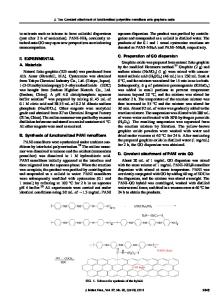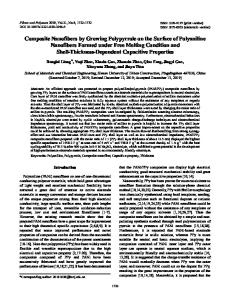Nitrogen-doped carbon “spider webs” derived from pyrolysis of polyaniline nanofibers in ammonia for capacitive energy st
- PDF / 569,741 Bytes
- 11 Pages / 584.957 x 782.986 pts Page_size
- 44 Downloads / 897 Views
Liud) and Yat Li Department of Chemistry and Biochemistry, University of California, Santa Cruz, California 95064, USA
Xiao-Xia Liub) Department of Chemistry, Northeastern University, Shenyang 110819, People’s Republic of China (Received 20 September 2017; accepted 6 November 2017)
Heteroatom-doped carbon materials have attracted immense interest as advanced supercapacitor electrode materials due to their unique properties. A carbon cloth-supported, nitrogen-doped carbon “spider web” network full of macropores and mesopores is developed via the pyrolysis of polyaniline nanofibers in ammonia atmosphere. The presence of mesopores and macropores can provide ion-buffering reservoirs to shorten the ion diffusion distance to the interior part of the carbon network. Carbonization in ammonia introduced N heteroatoms through gas phase chemical reactions between ammonia and the oxygen functionalities on the carbon surface. The enhanced ion-accessible surface area and improved charge transfer rate can be achieved. The N-doped carbon “spider web” exhibited a high specific capacitance of 266 F/g at a scan rate of 2 mV/s. Even when the scan rate was increased to 500 mV/s, 61% of its capacitance could still be retained, evidencing its excellent rate performance. The demonstrated strategy is anticipated to be generally effective for preparing heteroatom-doped carbon electrodes with other polymers.
I. INTRODUCTION
Currently, tremendous research efforts have been attracted to explore clean and sustainable energy to power our civilization due to the growing population and limited supplies of fossil fuels.1–4 However, effective and feasible utilizations of these energy sources are still facing a number of challenges, such as seeking strategies to cope with the intermittent and unstable nature and uneven regional distribution of most sustainable energy sources.5,6 Developing reliable energy storage devices that enable storage, employment, and distribution of the harvested, clean, and sustainable energy regardless of time, space, and location is therefore a promising strategy deserving long-term research endeavors.7–9 Supercapacitors, also known as electrochemical capacitors or ultracapacitors, are a family of energy storage device competent to store and release energy with ultrahigh power and super-short time (e.g., in seconds or even subContributing Editor: Marcus A. Worsley Address all correspondence to these authors. a) e-mail: [email protected] b) e-mail: [email protected] c) These authors contributed equally to this work. d) This author was an editor of this journal during the review and decision stage. For the JMR policy on review and publication of manuscripts authored by editors, please refer to http://www.mrs. org/editor-manuscripts/. DOI: 10.1557/jmr.2017.443
seconds).10–15 The remarkable power density of supercapacitors is at the root of their charge storage mechanisms, i.e., by forming electrical double layer capacitance (EDLC) and/or proceeding with pseudocapacitive reactions.1 EDLC comes from the electrostatic cha
Data Loading...











